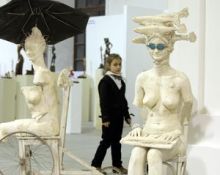For the first time the exposition of the Grand Sculpture Salon is located on the renovated 8,000 square meters of Art Arsenal. Such grand scale and the new location have noticeably influenced the perception of this event. The artworks seem to feel significantly freer and more organic here than in the Ukrainian Home, the site where the previous four Grand Sculpture Salons were held. Along with other artistic events they never managed to stifle the bad odor from the Ukrainian Home’s past — it used to be the Lenin Museum. The history of Art Arsenal is not simple either, but its interiors are significantly better suited to serve art. Over the last two months, following the official “new birth” of Art Arsenal, it has been visited by more than 50,000 people. Further development of this space will follow the strategy that has been elaborated by the Arsenal’s team, together with the Institute of Strategic Studies.
“DEGAS’ SPACE”
Edgar Degas plays the role of star guest at the Grand Sculpture Salon 2011. Exhibited in “Degas’ Section” are the master’s 74 bronze sculptures, reproduced from a depository of wax figures and made in the famous foundry workshop of Valsuani (France), on order of the artist’s relatives after his death. The full collection of sculptural masterpieces by the master of French impressionism, owned by Ihor Voronov, a Ukrainian businessman and art patron, is presented in Ukraine for the first time. According to arts critics, these studies in plasticity most definitely reflect the artist’s creative mood in the period when he abruptly started losing his sight. In sculpture Degas abides by the motives of his paintings (he was, after all, a painter first); the master would always be inspired by subtle shapes of dancing or bathing beauties and the graceful shapes of horses. In particular, the Grand Sculpture Salon presents the Young Dancer, the only sculpture that Degas exhibited within his lifetime, and which subsequently became one of the best-known sculptures in the world.
A separate section was set up at the Grand Sculpture Salon to exhibit his works. It is under the care of Yevhen Karas, a Kyivan gallery owner. The curator provided “Degas’ Space” with a range of technical resources — music, video, lighting and, of course, an informational component. All this together with the sculptures proper has created a totally different effect of perception of the art as such, which was not accessible to the Ukrainian spectator before. For the first time in Ukraine, masterpieces of globally recognized art are presented in the form of a multimedia project, rather than a traditional exhibition. It is an integral space, “Degas’ Space.” This approach resembles the ones seen in modern European museums. And this method is worth accepting as a norm in Ukraine as well. However, such technique costs quite a lot. Far from all national museums can afford such solutions, not to mention regional ones...
“A SPLENDID SCULPTURAL FOREST”
The second “wing” of the Grand Sculpture Salon 2011 is comprised of sculptural works by 40 leading Ukrainian masters. According to Natalia Zabolotna, Mystetsky arsenal’s General Director, in contrast to the previous years, when masters had to be sought for, this time the organizational committee could even afford to screen out 20 of the 60 sculptors who were nominated for participation in the Salon. A couple of years ago already art critics started saying that due to the Grand Sculpture Salon a relative niche in the domestic art market had finally taken shape. At last artists started coming out from their workshops, where they had been confined in previous decades and which were unfavorable for self-development or financially unprofitable.
“If the first Grand Sculpture Salon in 2007 was named a sculptural garden, now after five years of its existence it can be named a splendid sculptural forest,” says Oleksandr Soloviov, Mystetsky arsenal’s Deputy Director-General for Museum and Exhibition Activities and Art-marketing.
SculptorVasyl Byk gives a more reserved assessment of how sculpture is developing in Ukraine.
“Many sculptors are working and finding their style nowadays,” he says. “I hate criticizing my colleagues, but far from every Ukrainian sculptor’s works are to my liking. If there is now a ‘black hole’ in the world, then why should we as artists reflect it in art as well? On the contrary, let us pull people out of this ‘black hole’ and show what is beautiful,” appeals Byk.
AND ONCE AGAIN ABOUT THE LAW...
One of the traditional conversation topics of the art-forum has become the problem of transporting cultural items. Indeed, transferring art in and out of Ukraine continues to be taxed, unlike in most European countries. Nevertheless, this legislative norm is still in effect in Ukraine. However, as Zabolotna told us, the new Tax Code abrogates the import duty on artwork that is over 50 years old. Although there are some small advances, they have no influence whatsoever on our contemporaries who would have to be the first to promote Ukraine and its art in the world. “In governmental offices modern art is still regarded as a commodity,” states Zabolotna.
By the way, Voronov, one of the biggest Ukrainian collectors (who owns the full collection of Degas’ plastic art), asserts that there is even a lobby in the parliament already, which would insist on changing the rules for the transport of cultural items. These are people with fairly large collections of modern art, as Voronov asserts; however, the MPs are not in a hurry to make a show of their noble passion, explaining it by the “political expediency.” According to Zabolotna, much hope is currently pinned on the Customs Code where, as she expects, it will be possible to establish civilized norms, which would be friendly to the Ukrainian art.
The Grand Sculpture Salon will be open daily till March 13, from 11:00 a.m. to 8:00 p.m. In addition, live transmission of the exhibition will be available till March 13 on Art Arsenal’s website (arsenal.in.ua).










